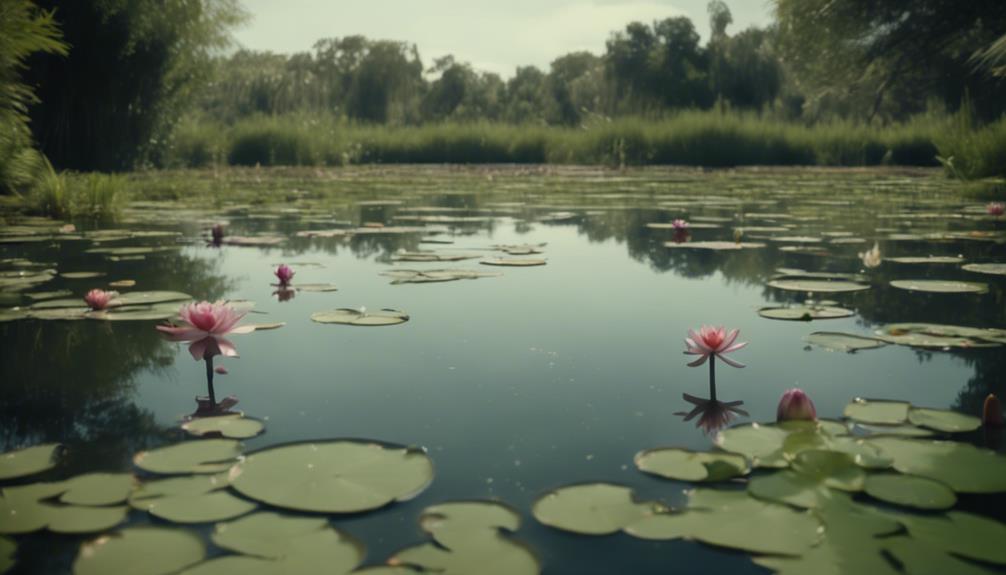You can effectively control algae in your pond by implementing three key strategies. First, use physical removal methods like skimming and vacuuming to target surface-dwelling algae. Second, employ biological control methods, such as UV clarifiers and beneficial bacteria, which specifically target algae cells. Third, prevent algae growth by maintaining a balanced ecosystem through regular removal of excess nutrients and debris. By understanding the complex factors that fuel algae growth, you'll be better equipped to take a holistic approach to regaining control of your pond's ecosystem, and by exploring further, you'll uncover even more nuanced solutions to achieve ideal water quality.
Table of Contents
Key Takeaways
- Regularly monitor and maintain pond water quality to prevent algae growth by removing excess nutrients and debris.
- Implement physical removal methods, such as skimming and vacuuming, to control surface-dwelling algae.
- Use biological control methods, like UV clarifiers and beneficial bacteria, to target algae cells specifically and effectively.
- Add aquatic plants to absorb excess nutrients, reduce direct sunlight, and release oxygen, thereby preventing algae growth.
- Maintain a balanced ecosystem by implementing proper fish feeding practices and providing shade for at least 40-60% of the pond's surface area.
Understanding Algae Growth Factors
As you explore the world of pond management, understanding the factors that contribute to algae growth is vital.
Several key factors, including light, temperature, nutrients, and water chemistry, influence algae growth in ponds.
You'll notice that algae thrive in areas with direct sunlight, where they can absorb nutrients and CO2 from the water.
Excess nutrients, often resulting from excess waste, fertilizers, or agricultural runoff, provide a fertile ground for algae to grow.
Water temperatures also play a pivotal role, with different types of algae preferring specific temperature ranges.
For instance, filamentous algae tend to dominate in cooler waters, while green algae and blue-green algae thrive in warmer temperatures.
Single-celled algae, on the other hand, can grow in a wide range of temperatures.
Effective Removal Techniques Explained
When it comes to effectively removing algae from your pond, you'll want to employ a combination of physical, chemical, and biological methods that target the specific type of algae present. This multi-faceted approach will help you control algae growth and prevent algae blooms.
| Removal Method | Effectiveness |
|---|---|
| Physical removal (skimming, vacuuming) | Effective for surface-dwelling algae, but may not remove suspended algae |
| Chemical treatment (algaecides) | Can be effective, but may harm beneficial organisms and require repeated applications |
| Biological control (UV clarifiers, beneficial bacteria) | Targets algae cells specifically, can be used in conjunction with other methods |
Prevention and Maintenance Strategies

By taking proactive steps to prevent algae growth, you can maintain a balanced and healthy pond ecosystem.
One of the most effective ways to do this is by implementing regular maintenance routines. This includes monitoring pond water quality, removing debris, and managing nutrient levels.
Add aquatic plants: These plants absorb excess nutrients, reduce direct sunlight, and release oxygen to the water, creating a balanced environment that discourages algae growth.
Implement proper fish feeding practices: Only feed your fish what they can consume within a few minutes to reduce waste and excess nutrients that contribute to algae growth.
Maintain a balanced ecosystem: Regularly remove excess nutrients and debris to minimize the conditions that favor algae growth.
Provide shade: Block excessive sunlight by providing shade for at least 40-60% of the pond's surface area using aquatic plants, which can help reduce the likelihood of algae blooms.
Frequently Asked Questions
How to Control Pond Algae Naturally?
You can prevent algae blooms naturally by introducing beneficial bacteria, managing aquatic plants, and maintaining a healthy habitat through eco-friendly practices, such as carbon dioxide reduction, natural nutrient reduction, and oxygen level increase.
What Is the Best Treatment for Algae in Ponds?
You'll be surprised to know that 70% of pond owners struggle with algae blooms! For the best treatment, consider a multi-faceted approach: chemical treatments, algae-eating fish, UV clarifiers, oxygen infusion, algae suppression systems, bacteria supplements, aquatic plant management, and pond aeration systems.
What Is the Best Method to Control Algae?
You'll find that a multi-faceted approach works best to control algae, combining algae testing kits, aquatic plant management, and water circulation systems with ultrasonic devices, algae eating fish, and oxygen infusion systems to prevent growth.
How to Clear Green Pond Water Naturally?
You can clear green pond water naturally by removing excess organic matter, promoting sediment removal, and maintaining a natural balance that supports aquatic life, ultimately achieving clear waters and ecosystem health through regular pond maintenance and biological agents.
Conclusion
By now, you've learned that controlling algae in ponds requires a multi-faceted approach.
Remember, 'an ounce of prevention is worth a pound of cure.'
Regular maintenance, effective removal techniques, and understanding the growth factors are vital to keeping your pond healthy and thriving.
By implementing these strategies, you'll be well on your way to a balanced ecosystem, where aquatic life can flourish and algae growth is kept in check.

